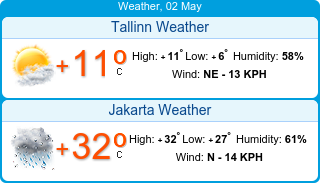Estonia at a Glance
Geography
Area: 45 227 square km
Borders:
Total length: 1 450.2 km, with a sea border of 768.6 km and a land border of 681.6 km
Distances from Tallinn to:
- Helsinki 85 km;
- Riga 310 km;
- St. Petersburg 350 km;
- Stockholm 375 km.
Climate: humid-temperate
Number of islands: 1 521. Largest islands are Saaremaa, Hiiumaa and Muhu.
Estonia is a green land, forests cover 55% of the country .
Estonia is a country of thousand of lakes, largest of these are Lake Peipsi and Lake Võrtsjärv
Highest point: Suur Munamägi (Great Egg Hill), 318 m
Temperature range (average daytime, EMHI): -2,0°C in winter (may sink to -20°C usually in February) and +19.4°C in summer (may rise to +30°C usually in July).
Population
The last official census was taken in 2012.
Population: 1,3 million (Source: Statistics Estonia)
Population density: 31 inhabitants per square km
The proportion of urban population (2011): 68%
The proportion of rural population (2011): 32%
Largest ethnic groups: Estonians (69%), Russians (25%), Ukrainians (2%), Belarussians (1%) and Finns (1%).
Main Cities
The capital of Estonia is Tallinn (401 thousand inhabitants or 29.8% of total population).
Other large cities and population (thousands):
Tartu - 104 100
Narva - 65 200
Kohtla-Järve - 43 800
Pärnu - 43 800
Currency
From 1 January 2011 the currency in Estonia is euro.
Tax system
21% flat income tax, reinvested corporate profit is tax free; 20% VAT
Education
Compulsory school attendance in Estonia begins at the age of 7 and lasts until completion of basic education, which cover the grades 1-9 or up to the age of 17. Basic education is funded by the state budget and the local government.
Language
The official language in Estonia is Estonian which belongs to the Finno-Ugric language family and is closely related to Finnish. Along with Finnish, English, Russian and German are also widely spoken and understood.
Religion
Since the Reformation movement in the 16th century, the Lutheran church has played the leading role in Estonia. Other larger active confessions are: Greek Orthodox, Russian Orthodox, Baptist, Methodist and Roman Catholic.
State
Type: parliamentary democracy.
The Constitution of Estonia came into force in 1992 and is, in a number of ways, a compilation of aspects of Estonia’s previous constitutions. It has continued the democratic spirit of the 1920 Constitution, with some added mechanisms to maintain the balance of power of the state.
Head of the State: the President, who is elected by the parliament or an electoral body. Term: 5 years. Current President: Mr. Toomas Hendrik Ilves, elected for a second term by the Parliament on August 29, 2011. Next elections: Autumn 2016.
The President has mainly representative functions, although he still retains a number of executive powers. The President may veto a parliamentary bill and have it sent back for revision, and his signature is required when appointing the Ministers of the Government. He is also empowered to present the parliament with the names of several higher officials. The President is also the supreme commander of the armed forces.
National legislature: the Riigikogu. A unicameral parliament of 101 members. Term: 4 years. Last elections for the 12th Riigikogu: March 2011.
The executive power is exercised by the Government headed by the Prime Minister (currently Mr. Andrus Ansip from Reform Party). The parliament is empowered to appoint and recall the Prime Minister. As a counterweight, the Government can dismiss the parliament, with the consent of the President, and call new elections if the parliament expresses no confidence in the Government.
Highest judicial power: Supreme Court
The court system is divided into three levels: courts of first instance (county and city courts and administrative courts), courts of appeal (circuit courts) and the Supreme Court which also functions as a constitutional court.
The legal system is based primarily on the German model, especially within the field of civil law with which it has direct historical links. The courts are independent, judges are appointed for life and may not hold any other elected or appointed public offices.
The Estonian legal system is subject to international law as well as European Union law. Consequently, general principles and norms of international law and directly applicable rules of European Union law form an integral part of national legal system.
Other institutions
The Constitution provides for a national bank, independent of the Government, which operates as the bank of issue. It also provides for the office of the Chancellor of Justice whose task is also to be Ombudsman. The third office is that of the office of the Auditor General. The Governor of the central bank Eesti Pank, the Chancellor of Justice and the Auditor General are appointed by the parliament at the proposal of the President, but in their functioning they are independent government officials and cannot be dismissed by the parliament before serving a full term.
The Constitution provides for two further types of government with a large degree of autonomy – local governments and cultural self-governments of ethnic minorities.
Administrative division: 15 counties, 33 towns and 194 rural municipalities.
Electoral systems: proportional representation. There is universal suffrage for Estonian citizens over 18 years of age. Municipal elections: Term: 4 years. All permanent residents over 18 years old, regardless of citizenship are eligible to vote in municipal elections. The last elections for local authorities were held on 18 October, 2009. Next local elections: October 2013.
Honorary Consul of the Republic of Estonia
Special Capital District of Jakarta
Jl. Pinang Emas III/17, Pondok Indah
Jakarta 12310, INDONESIA
Phone. 0812 199 4488
This email address is being protected from spambots. You need JavaScript enabled to view it.
www.consulateestoniajakarta.com
Office hours: 08:00 a.m to 01:00 p.m
Appointment with Consul (H)
Youtube: Adriana Sri Lestari

































